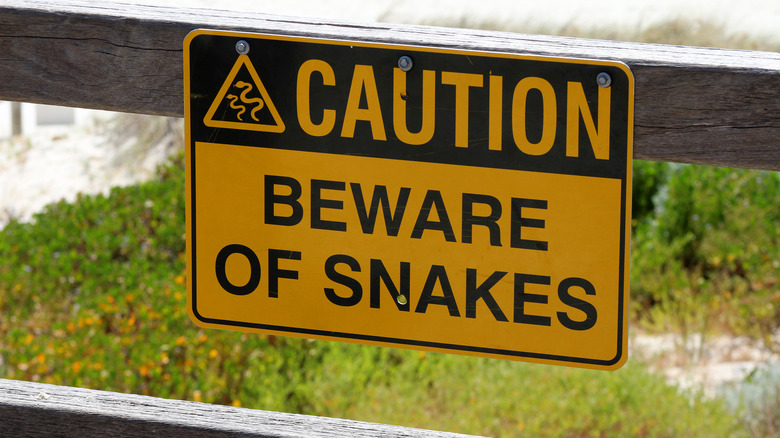4 Ways To Get Rid Of Garter Snakes In Your Yard Without Hurting Them
Garter snakes (thamnophis sirtalis) are generally 1 to 2 feet long, with some even attaining 5 feet. Colors vary, but consistent is a whitish underbelly and stripes down their bodies. They have forked tongues that are red with a black tip. According to National Geographic, there are more than 3,000 snake species worldwide, the bulk of which are neither poisonous nor harmful to humans. The 30 species and additional subspecies of garter snakes are benign and often beneficial yard dwellers. They cull many garden enemies, and as Eartheasy notes, their primary diet consists of your vegetable pests, bulb eaters, and perennial chompers, along with the occasional rodent.
The common garter snake is thriving throughout North America. Unfortunately, it might also be thriving in your yard. A backyard offers ample shade, shelter, hiding places, a robust food source, and available water — in short, it is a serpent's paradise. Garter snakes are actually shy, non-aggressive, and wary of humans. However, despite their retiring nature and helpful eating habits, garters are on the unwelcome list of most homeowners. As a result, there are many harmful, even lethal ways used to get rid of the snakes. However, there are also plenty of ways to keep your yard relatively snake-free using merciful, but effective methods.
Alter the environment
Backyard Farmer says keeping garter snakes out of your yard is essentially a matter of making it inhospitable to them. A fence is an essential step. The Minnesota Department of Natural Resources suggests installing a chain-link, picket, or railed fence around the yard and attaching vinyl mesh, cloth, or aluminum flashing to the bottom. Bury the attachment several inches deep, and angle the fencing outward. Any gates should be similarly snake-proofed and kept closed.
A well-maintained yard is not attractive to snakes. Grass kept short (1 inch or less) will deprive garter snakes of a hiding place. It will also make them more visible to you. Moreover, having short grass will make the snakes easier for predators to see. According to Bug House Pest Control, snakes hide in the shade of tall grass but don't be surprised to see them out in spring and summer basking in the sun. In addition, flower beds, which are a snake favorite, should be kept clean.
Planting lemongrass around the yard's perimeter will repel garter snakes along with ticks and mosquitoes. Planting the Mother-In-Law's Tongue (also known as the snake plant) is also a good addition as its sharp leaves deter snakes from getting too close.
Learn their habits and adjust yours
Becoming familiar with a garter snake's habits and preferences is another important step in controlling them and keeping them away. Look for garter snakes on the prowl for rodents in the cracks and crevices of stone walls, which is a mutual hiding and hunting place. Likewise having standing water or excessive moisture on your property is an invitation for garter snakes and others. The reptiles will seek their prey there. Some garter snakes are even excellent swimmers.
Inspect for snakes underneath sheds or outbuildings. Mulch attracts snakes and their prey, so one might find a garter snake in the midst of it. My Move says if you must have mulch in your yard, sharp-edged contents such as eggshells or coral can be included to keep snakes away. A garter might opt to hide in a rock pile, however, individual sharp rocks are also good deterrents. A woodpile is a snake favorite, so think twice before having stacked firewood in your yard. Be mindful that snakes have also been known to hang around birdhouses, and a coiled garden hose just might have a coiled garter snake within.
Use harmless garter snake repellents
A full arsenal of repellents is at your disposal and are able to deter snakes without harming them. Most commercial ones depend on disrupting a snake's well-developed sense of smell. Some contain cinnamon and clove scents while others use naphthalene and sulfur. AG Daily describes solar-powered stakes that emit sound waves through the ground over a wide area and claim to drive snakes out, but it is still unclear whether snakes can hear such frequencies. Some snake opponents use bird decoys whose efficacy is also debatable.
A DIY repellent spray consisting of oil and onions, or garlic, is an effective deterrent when aimed at potential hiding places. Apply copiously and replenish as needed, especially after it rains. Essential oils might also do the trick, among them lime, peppermint, hot pepper, and the aforementioned cinnamon and clove. AZ Animals touts ammonia as a reliable snake repellent. They suggest infusing old clothes with ammonia, placing them in open plastic bags, and leaving the parcels where snakes have been noticed earlier. If your property has a pool, dosing spots around it with vinegar might also work. Per The Rustic Elk, fox urine is available at farm supplies stores and, when strategically placed, has been proven to put off snakes. Garter snakes also avoid cedar in the form of oil or shavings, and they are known to steer clear of human or pet hair scattered around the premises.
Take action
In winter, garter snakes hibernate in dens where up to hundreds of the reptiles may be housed. They might choose to set up shop in an abandoned animal burrow, so fill them with dirt or gravel. Minimizing the amount of debris in your yard is a helpful deterrence. Compost piles should also be kept at a minimum. It is advisable to check around your house, along the foundation, beneath the stairs, or in retaining walls for potential entry points, according to Snake Removal Nationwide Service. Foundation holes or cracks should be repaired, and attention should also be paid to any issues in the spaces between the house, stoop, or patio.
Maintaining a smoking fire pit will dissuade a garter snake from your yard. Store-bought traps are another option. Snakes can be captured and relocated to a wooded area away from your home. Glue boards, which sound cruel but apparently do not harm the reptile, are commercially available. Applying vegetable oil will dislodge the trapped animal, which can then be safely moved. However, given the benefits a garter snake provides, perhaps the most effective way to deal with it sharing your yard might simply be to live and let live.




